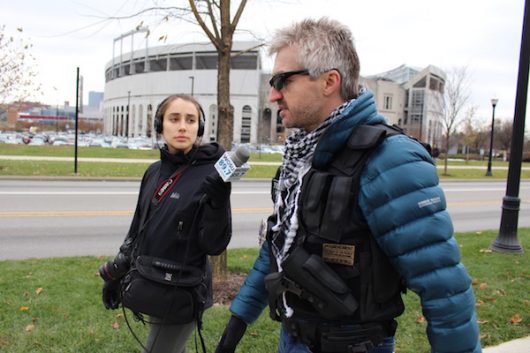
Merrill Kaplan, a professor in the English and Germanic departments discusses gun rights with openly carrying protesters on campus on Dec. 5. Credit: Nick Roll | Campus Editor
One week after an attack which left 11 people in the hospital and the attacker shot dead, a group of protesters came to Ohio State, quietly walking through campus with guns strapped across their chests.
The protesters were in favor of Ohio House Bill 48, pending legislation which could allow for concealed carry on public college campuses in Ohio, among other places where concealed carry is currently restricted. The bill wouldn’t allow concealed carry outright, but would allow colleges to opt in. University President Michael Drake recently spoke out against the bill during a segment on WOSU.
The timing of protest, referred to as “a walk,” just after the attack, was intentional, said Jeffry Smith, the organizer.
“The purpose of these walks, in general, is to advocate for conceal and carry … legal conceal carrying in Ohio,” he said. “Secondarily, to engage in dialogue with people about firearms rights and privileges.”
Smith named the walk “No More Sitting Ducks,” which is what he said college students are without concealed carry, especially in light of the recent attack. Abdul Razak Ali Artan, the attacker, was killed within two minutes by a University Police officer who was already near the area.
Ohio State’s code of student conduct prohibits students from open carrying on campus, but the protesters, none of whom were students, were in the clear under state law.
“The organizers proactively notified the university of their intent to conduct this educational walk involving the legal possession of weapons, which will occur on and around campus,” said Dan Hedman, spokesman OSU’s Office of Administration and Planning. “The Ohio State University Police Division will have a visible presence during the event to promote safety and to protect the rights of all members of the university community.”
Some students, however, expressed concerns with the policing of the event and one faculty member said she felt caught of guard seeing a group of armed people walking through campus. Due to the highly politicized nature of gun rights, many bystanders, whether they sided with the protesters or were against them, did not share their full names with The Lantern.

A protester speaks with a WOSU reporter while walking past The ‘Shoe on Dec. 5. Credit: Nick Roll | Campus Editor
The protesters spent much of their time trying to engage with passersby, asking them if they had any questions about gun laws in Ohio, and why the protesters came to campus.
How much progress was made, however, was unclear.
“Here is my point of view, I find you frightening, I find this very frightening,” said Merrill Kaplan, a professor in the English and Germanic departments who met the protesters with a sign reading “I feel unsafe.” Kaplan and the protesters discussed their differing interpretations of gun rights on the sidewalk outside of Denney Hall.
What seemed to emerge were two competing feelings of safety — one that would require citizens to carry guns, and one that would require those guns to be gone.
“One of my nightmare scenarios is that an attacker bursts into my classroom, with a weapon, and that students leap to their feet and there’s crossfire, and there are several people who armed, who are not law enforcement, who make the situation more complicated, with more lead in the air,” Kaplan told the protesters. “The chances of that happening go up when there are people in that room who have guns.”
The protesters, however, countered her argument — after all parties acknowledged they wouldn’t agree on the issues at hand — by saying that other college campuses have concealed carry, and her fear hasn’t come to fruition.
The protesters shook Kaplan’s hand before wrapping up their day, about two and a half hours after it began.
Jacob Myers contributed to this article.


